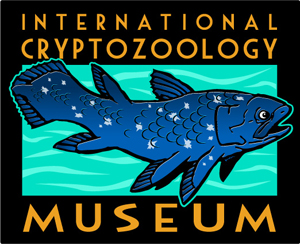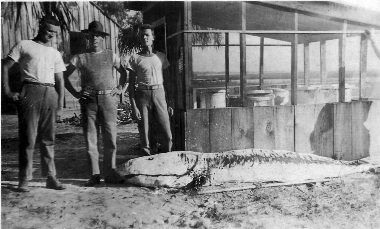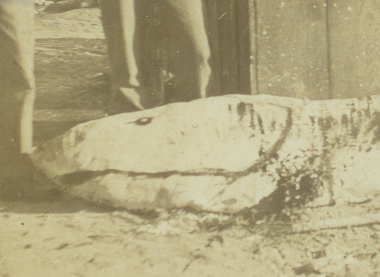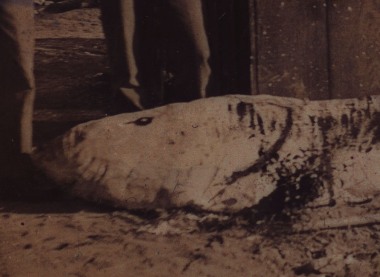Mystery Fish Photograph Revisited
Posted by: Loren Coleman on July 11th, 2008
People seemed to have so much fun yesterday with the alleged Bigfoot image from near Mt. Hood, it feels like your magnifying glasses may be polished off for another look at the “Mystery Fish Photo.” If you are new here, then you have to see this one too, and have your say.

As oldtimers may recall, despite speculations, theories, thoughts, rumors, ideas, hypotheses, and claims, this longest standing mystery at Cryptomundo has never been fully solved.
The postcard photo, originally sent to me by Phyllis Mancz of Ohio, has become such an enigmatic icon that it became part of the design on the front of my new edition of Mysterious America.
The Mystery Fish postcard, first noted here on November 29, 2005, has never been identified, as to exact location or species. New people sometimes have new ideas. Lots of new readers may not be familiar with this Cryptomundo mystery. So here goes….(if you are a seasoned Cryptomundian, please have patience; a new look might really help).
(Click on image to see full size version, enhanced by shockbeton)
Due to research (see below) on the type of postcard it is, there was a determination that this specific item would have been produced between 1904-18.
The location seems to be in the Pacific; perhaps it was taken in the Philippines. Or maybe even Florida?
One reader said this might be during WWI, in the south of France, because of the uniforms, but what of those palm trees? Where are these trees found? Can you identify the kind of trees?
Due to several requests for a closeup of the head of the mystery cryptid on the postcard, here’s a computer enhancement.
What do you see here?
(Click image for full-size version)
(Click image for full-size version, provided by Todd DiLaMuca)
(Click image for full-size version, provided by Todd DiLaMuca)
Here is a roundup of direct links to some of the “Mystery Fish Photo” entries in the Cryptomundo.com blog, which were posted in 2005 and 2006:
“Name the Mystery Fish Continued”
Reactions continued, as well, into 2006: “Mystery Fish Revisited”
And more recently.
Nearly 400 comments, most of them extremely thoughtful and detailed, can be found at the above noted entries, and yours are welcome anew, here, below. To date almost 4,000,000 views of the Cryptomundo “Mystery Fish” photo have occurred.
(Click image for full-size version, provided by Todd DiLaMuca)
+++Date of the Postcard++++
The earlier discussions noted the date was between 1904-1918 for this postcard. For example, in this hyperlinked blog (please click), the entire back of the postcard is pictured. Various pieces of research exactly determined that the diagnostic direction of the triangles give forth with a specific range of when these postcards were produced. While the men and the fish could have been photographed before 1904, it seems they could not have been photographed and appeared on this card after 1918.
The window of time for the producing of the card stock is, therefore, most probably, between 1890 and 1918.
^^^^^^^^^^^^^^^^^^^^^^^^^^^^^^^^^^^^^^^^^^^^^^^^^^^^

“Save The Museum”: Easy-to-use donation buttons are now available here or merely by clicking the blank button below. Thanks everyone!
Or you may directly send a check, money order, or, if outside the USA, an international postal money order made out to
International Cryptozoology Museum
c/o Loren Coleman
PO Box 360
Portland, ME 04112
About Loren Coleman
Loren Coleman is one of the world’s leading cryptozoologists, some say “the” leading living cryptozoologist. Certainly, he is acknowledged as the current living American researcher and writer who has most popularized cryptozoology in the late 20th and early 21st centuries.
Starting his fieldwork and investigations in 1960, after traveling and trekking extensively in pursuit of cryptozoological mysteries, Coleman began writing to share his experiences in 1969. An honorary member of Ivan T. Sanderson’s Society for the Investigation of the Unexplained in the 1970s, Coleman has been bestowed with similar honorary memberships of the North Idaho College Cryptozoology Club in 1983, and in subsequent years, that of the British Columbia Scientific Cryptozoology Club, CryptoSafari International, and other international organizations. He was also a Life Member and Benefactor of the International Society of Cryptozoology (now-defunct).
Loren Coleman’s daily blog, as a member of the Cryptomundo Team, served as an ongoing avenue of communication for the ever-growing body of cryptozoo news from 2005 through 2013. He returned as an infrequent contributor beginning Halloween week of 2015.
Coleman is the founder in 2003, and current director of the International Cryptozoology Museum in Portland, Maine.














It looks like the head is slightly angled and it appears like the it has a somewhat flat nose. The side looks like some details are obscured by light below the black stripe, so maybe it is a finned shark with the tail cut off? It would make sense within the setting but I can’t see why the men would take off the fins and tale for a photo. When looking at the tail end of the fish, I think I can see some sort of part of a tail (not a tail fin) that could propel it. I don’t know I’m stumped. It’s quite the photo though.
Oh I almost forgot, looking at the scenery in the photo I wonder if perhaps it is taken in Hawaii, it’s hard to tell but Hawaii has lots of big fish come through.
Loren, actually that is date when the card stock was manufactured. Remember, I pointed out in an earlier post in a thread, that it could have been printed many years later using that card stock? So the date of the card stock is not in question. But the date when the negative was printed on the card stock is in question. It could have been during World War II or even later.
I would also give a good look at the tail of the fish and not just the head. The tail does not resemble any shark tail I have seen but more of a carp like tail to that fish.
Looks like a shark with it’s fins cut off
I was wondering about the man in the hat, it looks like type a drill sargent wears. If so, how many military training facilities were located along the ocean? Although, many early military posts conducted training so this may not pan out.
I think its a shark and the location is somewhere in the South Pacific. The American military has had a pretty large presence in the Pacific for a long time. Also the missing fins, aren’t shark fins considered a delicacy or for medicinal reasons? I remember watching a program about the South Pacific and the overharvesting of sharks for their fins.
My first impression is that it is not a fish at all, but an inanimate object poorly painted to look like a fish. If it is a fish, I agree with the “finned shark” theory.
Well, I am not too sure what species it is, however, I plan on referencing it to http://www.fishbase.org which is an amazing site for identifying fish. I highly recommend more people do this, and maybe we can come up with an answer, or even narrow the possibilities.
Still-born, premature whale?
never mind – didn’t look closely at the tail
I believe the uniforms are not French, but American, and the palm trees and outdoor field kitchen suggest the Philippines where there was a large American presence during the eleven campaigns of the Philippine Insurrectiopn from 1899 to 1913.
It can be the southern France, they have the palm trees there. Here you can see some pictures of the palms in Nice:
http://www.francemonthly.com/n/1102/index.php
It’s head looks a lot like a frilled shark, but having no fins, that doesn’t make any sense. Still look at this picture.
I havnt dug through the previous comments, but has it been suggested yet that the photograph itself has been tampered with, and that the mouth and eye were actually drawn onto it to make it look more like a fish?
With the new clearer images, I’m tempted to go with a piece of driftwood that was suggestive to these bored soldiers, who then drew the ‘eye’ and the ‘mouth’ on it. They are basically ‘flat’ to the rest of the object.
The face seems very snake like to me. Are you sure this is a fish and not a giant serpent?
My first thought has always been that its a finned shark (tiger shark specifically) in some level of decomposition.
jrenn responds:…..”Also the missing fins, aren’t shark fins considered a delicacy or for medicinal reasons? ”
Absolutely yes. I know a chinese family who had shark fin soup served at the oldest daughters wedding and were quite proud of this being on the menu.
The head screams serpent to me, the body is more questionable. It could pass for a serpent body with the no fins and all, but the gurth makes it seem not normal for a snake. I can’t see the end of the tail very well, but from what I do see it still says snake, one fatass snake.
As I stated in the 1st time this was posted,
100% MEGAMOUTH shark
I can’t go with the no later than 1918 summation. It looks to me that the middle man is a marine sergeant and the right fellow is a marine private. The guy on the left is not in a uniform so I believe he is a civilian contractor guessing by the look of his clothes, his haircut and his general appearance. Many pacific islands were being fortified for defense in the mid to late 1930’s and one of those was Wake island. Marines and civilian contractors were both there. Looking through the cook (maybe wash) house(?) one can see shorelines weaving back to the left of the picture. The trees and shrubbery also match what was there, too. I think the picture was taken between 1938 and December 1941. Marines and civilians were on Wake at that time. The fish looks as if it had been shot in the head and if it were a shark, that would make sense so as not to get bit as you haul it out of the water. I believe it was a shark or maybe some kind of eel. If someone knew a survivor of Wake, maybe they could identify the picture or the people in it or could say definitely its not Wake but maybe somewhere else.
I do believe, however, this was taken around the late 30’s because those “tubs” in the shack look like early washing machines and they weren’t that modern in 1918.
I stand by my “mutilated shark” idea, since the head looks very sharklike (if you look closely, you can see the head tapers to a point, partly obscured by the middle guy’s shadow). I suspect the eye and mouth aren’t actually part of the creature and may have been added in later…
I can see a ponytail and a braid…perhaps there was some sort of massacre that happened just out of frame?…
…I KID! I JOKE!
It honestly looks very much like a painted rock or driftwood.
What about something in the same family as the Eurypharynx Pelecanoides… ?
“those “tubs” in the shack look like early washing machines”
No wringers, which would be clearly visible in the photograph, and having washing machines outside may not be the best idea. However, what those “tubs” do look like to me is old style metal trash cans.
IF those are trash cans, then the identification of the mystery fish as a shark that has been skinned and had the fins removed for soup becomes very credible, as the rest of the carcass would be considered garbage. Its placement next to the trash cans then becomes easily explainable.
The shape of the head seens consistent with a shark, and the problematic extended mouth line could be a result of someone cutting the mouth opening wider to get at the jaws and teeth, which might be considered the only part of the shark worth saving after it had been de-finned and skinned
I don’t know if I’m just too noobish to know any better, but I think I see a long pole laying along side the creature. Could that mean they use a stretcher of some sort to transport the creature to that spot? If so then it may help to rule out the big rock or carved or painted piece of drift wood theory. And if it is a paint job then, WOW!!!! I’m convinced. 🙂
First off, if you Google dead shark this does not look anything like a dead shark. The mouth is totally wrong, wrong angle, wrong size and shape. And there are no teeth showing. If it was rotted and decayed, the teeth would not fall out as the jaw and teeth are the only bones in a shark. And where are the fins? They should be there are no cut marks it’s smooth no marks at all so this looks like it has no fins then. Also look where are the gills? If it’s a fish, there should be gills, but I don’t see any gills slits at all. If it’s not a fish, it would have to be some type of aquatic mammal like a dolphin or seal or whale but there are no fins either once again and I think it’s too small and stubby to be some kind of serpent unless most of the back half fell off due to rotting off them maybe. But I think this is just an elaborate fake these guys made up. And think about it if this was rotten they would have had to move it to this spot and I don’t think the belly would be so nice if it’s rotting it probably would have fallen apart and why would they move a stinking rotting fish when they could have taken pics right on the beach where they found it? No to me this is a fake.
I’m not an expert by any means, so my question to those who suggest it’s a finned and skinned shark: if it is a skinned shark, what is that black coloring running the length of it’s body? The head looks very shark-like though and I can understand, if it is a shark, why it may be missing the fins. The elongated mouth just reminds me of The Black Dahlia murder. O.O
When I look at the first of the enlargements of the head (the one that is the lighter sepia toned shot), I agree with the comment that there is little depth to the mouth line, gill slit, or eye. In that photo, it looks like a piece of driftwood painted to look like an eel. The dark coloration on the object looks like paint strokes in this image.
Also, why is there no mouth line in the third of the closeups?
Larry:
The “mouth line” was removed in one enhancement under the assumption that it was a smear of blood running from the gill line down towards the front of the head. It was removed to give viewers a view of the head without the suggested mouth line since it may not actually be the mouth.
It’s not a shark. I’ve seen a lot of dead sharks in my time, skinned and unskinned and this creature is not a member of the shark family. From the head back it is a white fish, skinned, with the blood vessels close to the lateral line showing clearly, much the same as any common white fish would do if it was skinned.
The head is very unfishlike. It says reptile to me too, so one suggestion I have is that it may be the head (or the complete skinned body) of a skinned Komodo Dragon or similiar (Indonesia) as these reptiles were routinely skinned and the hides and jaws sold to museums in the time frame we are talking about. If this is the case then the legs have been removed too and the body arranged to give the impression of being something else – not entirely improbable if you’re a bored serviceman on a boring beachhead. On the other hand, providing a museum with a decent skin might involve taking the legs anyway so leaving very little behind except for what is in picture. I have never skinned a Komodo Dragon so cannot tell you what they look like on the rest of their body, but it might in entirety not be disimiliar to what you see here, once all the “good” bits have been taken away.
Darned if the head doesn’t look a little like the Kogia sima head shown in the fourth photo down (the one with the labeling “Figure 1” in the frame) in Darren Naish’s post on that oddball cetacean. The rest of it doesn’t fit, but the head kind of startled me when I read Darren’s article.
Ummmm, maybe it’s just me, but people are attempting to identify this with something that is known. The problem is, this is an unknown animal, most likely in the reptile class, since the tail looks to have flopped sideways, which means if stood up it would propel this beast as a fish tail does, and there fore it cannot be a mammal. The Philippines in the early part of last century rings with the best guess I would make, mainly because, back then the standard military issue hat was very similar to the military style tyhe guy in the middle is wearing. Just look at a pic of Teddy Roosevelt and his ‘Rough Riders’ and many of those guys have similar hats like that. My best guess is that it is truly an unknown animal, that was caught by these guys, and they dragged it up on shore to take a shot, which is why there is so little decomposition. Hey, in tropical climes, decomposition happens very very fast. Try to see the forest through the trees. Unknown animal.
Easy Peezy lol this is a White Sturgeon. They are the biggest freshwater species in the USA (although they have been known to also inhabit salt water areas) and can weigh over 1,500 pounds, be 20 feet in length, and live for well over 100 years. And obviously are known as a kind of prehistoric fish. These days any hooked sturgeon over 5 feet must be released unharmed without being removed from the water as they are more than likely over 100 yrs old and are classed as “breeding stock”, as they are a slow growing and slow maturing fish. It isn’t a common occurrence that they be seen or caught as they are bottom dwellers.
They have one big gill where their head joins to the rest of the body. Problem solved 🙂
Goonch. eyes fit :
at least a little similar
geographical factors may not be though